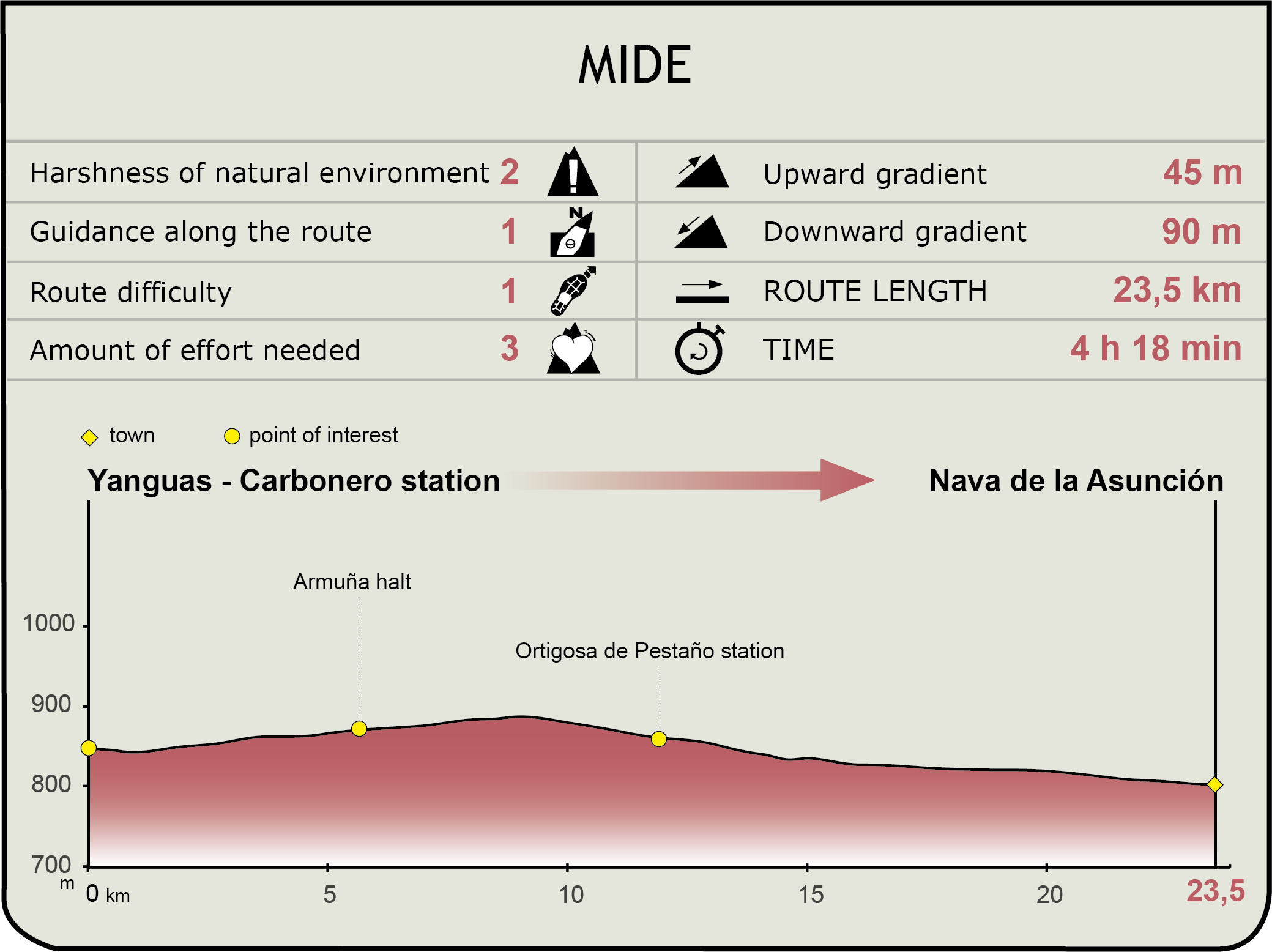- Home
- Rural Development
- Nature Trails
- Nature Trails
- Central Sector
- Valle del Eresma
Section 2: Estación Yanguas-Carbonero - Nava de la Asunción
Description

This section of the trail leaves the Eresma River behind and runs among cereal crops and resin pine forests
The second section of Eresma Valley Greenway Nature Trail starts at the Yanguas-Carbonero train station. It runs along the Eresma River and its riverbank woods, but leaves the river behind after the hermitage of Virgen del Tormejón. Following the rail tracks among cereal crops, the traveller will arrive at Armuña train stop and the towns of Miguel Ibáñez and Ortigosa de Pestaño (with its beautiful train station). Finally, the traveller will go through a resin pine forest (Pinus pinaster) leading to the end of the section in the town of Nava de la Asunción, Segovia.
The second section of the Eresma Valley Greenway Nature Trail starts at the Yanguas-Carbonero train station.
As soon as you leave the train station behind, you will find the Yanguas-Carbonero rest area and you will see a small rail service building to the right of the trail shortly afterwards, right before reaching kilometre 25.
Farther on, the traveller will see a stand of stone pines (Pinus pinea) and resin pines (Pinus pinaster) to the left of the path. The trail then crosses the 75-metre-long bridge over the Eresma River, allowing the traveller to enjoy the splendour of the riverbank forest guarding the riverbed.
Kilometre 27 is reached among poplar production groves and small pine stands, leaving the Caldillas mill to the left. If you want to see its remains, take the short detour from Eresma Valley Greenway Nature Trail. Then there is an area covered by cereal crops, in which the traveller may see flocks of indigenous sheep breeds of the province, such as the Churra, the Castellana [Castilian] (also the Negra variety) and the Ojalada breeds; and after several crossroads the traveller can distinguish the Virgen del Tormejón shrine.
Climbing a slight slope and leaving the Tormejón stream to your right, you will reach kilometre 30 and Armuña train stop, a modest building made from bricks, along with the ruins of several buildings related to the railway line. At this point, the trail turns left, crossing the SG-V-3311 road, which leads to the nearby town of Armuña, located to the right of the trail.
Having crossed the road, the traveller will go back to the original railroad, reaching kilometre 32. There, you will see the hermitage of Virgen del Prado to the right and, farther on, the town of Miguel Ibáñez. Miguel Ibáñez rest area will provide you with drinking water and a peculiar set of stones encouraging the traveller to take a break.
After a slight slope, kilometre 34 is reached, and a small descent among crop fields takes the traveller to the town of Ortigosa de Pestaño.
In order to arrive at the town, the traveller must cross the SG-V-3411 road, taking extreme precautions and leaving the biggest part of the town and the district known as La Estación to the right, along with the old and beautiful Ortigosa de Pestaño train station (Santa Maria de Nieva).
After kilometre 27, the Eresma Valley Greenway Nature Trail runs close to the Madrid-Valladolid-Palencia-León high-speed railway line (AVE), following 2,995 m of shared stretch along a wide dirt road. Walking along the AVE tracks, the traveller crosses a path linking the urban areas of Domingo García and Nieva.
Shortly afterwards, the traveller will reach the hermitage of Virgen del Pozo Viejo, next to the namesake rest area. These are located near kilometre 40, in a pine forest providing the traveller with a comforting shade.
The trail crosses the high-speed rail tracks through a bridge. A few metres ahead, the shared stretch finishes. The left branch must be taken at this point, leaving the rail tacks behind and to your right.
Well into the pine forest, the traveller can admire the beauty of the dominant species, the resin pine (Pinus pinaster), in resination. This is a process through which resin (a product with a high economic relevance and many purposes) is obtained.
A small forest haven to the right of the path can be seen before reaching kilometre 42. Then, the trail will take you through the pine forest, where there is a quarry to the left of the route, at kilometre 44.
The travellers exit the pine forest a few metres before reaching kilometre 46, already glimpsing the end of this section in the town of Nava de la Asunción. After walking a long straight stretch among crop fields and leaving some intersections behind, kilometre 48 and the SG-V-3413 road are reached, already in the town of Nava de la Asunción, where the second section of the Eresma Valley Greenway Nature Trail ends.
Sites of interest
Map
Puntos de Interés
Hidrografía
Vegetación
Profile

MIDE (Method for the Information of Excursions)
Featured
Further information
Nava de la Asunción
This town is located in the countryside of Segovia, in the region of Tierras de Santa Maria la Real de Nieva. In the past, it belonged to the City and Land Area of Coca, and it was known as La Nava de Coca until 1773. It takes pride on its important resin pine stands (Pinus pinaster) and it is included in the Vinos de Rueda Designation of Origin. Among the important architectural heritage of the town, the following can be highlighted: the church of Nuestra Señora de la Asunción, patron saint of the town; the hermitage of Santo Cristo de la Expiración, inside the town; the fountain of Caño del Obispo; and the rural houses of Casa del Caño.